Natural convection cooling describes a situation where there is no forced air flow from a fan, blower, or any other source. Under natural convection cooling, the temperature of the air within the heat sink's fins increases due to heat from the heat source. The higher temperature air is less dense than the surrounding air and rises our of the heat sink. This movement will generate a small amount of airflow within the heat sink fins, cooling the heat sink.
Due to the relatively low airflow generated by natural convection cooling, the fin pattern will need to be very sparse to provide optimal performance. A dense fin pattern will generate too much restriction to airflow, preventing the warm air from rising out of the heat sink efficiently.
Sparse fin pattern
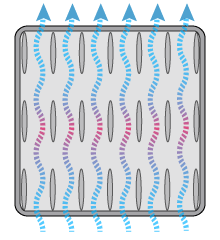
Heated air easily rises out of the heat sink
(Suitable for natural
convection)
Dense fin pattern
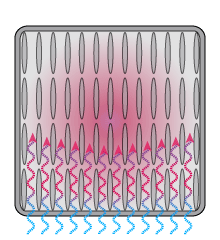
Heated air is trapped between fins
(Not suitable for natural convection)
We recommend our sparse fin/pin LPD-series or N-series for natural convection applications.
Heat sink attachment/orientation plays a significant role under natural convection.
It is recommended that the heat sink be installed to orient the fins in a direction that
will not block air movement under natural convection.
Fig.1 ( Fin up )
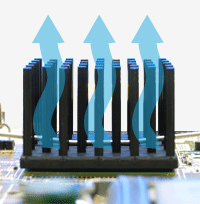
Fig.2 ( Fin side / vertical )
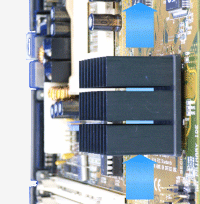
Fig.3 ( Fin side / horizontal )
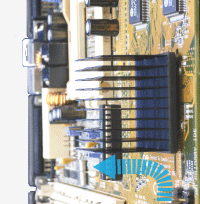
The heat sink should be oriented as in Fig.1 or Fig.2 under natural convection cooling.
Based on our testing, if the heat sink is oriented as in Fig.3, the thermal performance will be
approximately 25% worse than the Fig.2 orientation under natural convection condition.
If there is some slight air movement inside the chassis, the heat sink fin direction should match the airflow direction.
Pin fin type heat sinks, like the N-series, are Omni-directional, and offer much more flexibility in orientation.
Thermal performance under natural convection cooling is greatly dependant on environmental conditions. We strongly recommend that performance in the actual environment be verified.
Surface finish will affect the emissivity of a surface and its ability to dissipate heat through radiation. We recommended the use of an anodized finish under natural convection. Since an anodized surface offers higher emissivity than bare aluminum, the thermal performance will be better. Under natural convection, unlike forced convection, the amount of heat dissipated through radiation can become significant.
Our natural convection heat sinks (LPD-series, N-series) come with an anodized surface finish.
Under natural convection cooling, the thermal resistance value(°C / W) will change based on the power dissipation of the heat source. Higher power dissipation will generate more heat and greater natural convection air flow. This will improve the performance of the heat sink, lowering the thermal resistance.
In case of natural convection cooling, the relationship of the power consumption and temperature rise can be formulated as follows.
W = β ⋅ Δt ^1.25
By determining the β, the temperature rise (Δt) and the thermal resistance can be calculated
at a given wattage
You can calculate the β from our catalog data (thermal resistance and the wattage).
© 2012-2022 Alpha Company Ltd.
